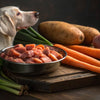How Many Grams of Raw Dog Food per Day: A Comprehensive Guide for Pet Owners
- Houndsy
Table of Contents
- Introduction
- Understanding Raw Dog Food
- Determining Daily Serving Sizes
- Practical Tips for Feeding Your Dog Raw Food
- The Role of the Houndsy Kibble Dispenser
- Common Challenges in Raw Dog Feeding
- Conclusion
- Frequently Asked Questions (FAQ's)
Introduction
Did you know that the dietary needs of dogs can vary significantly based on their age, weight, and activity level? As pet owners, we all want what’s best for our furry friends, and that includes their daily nutrition. A well-planned diet can contribute to better health, improved energy levels, and a shinier coat.
In recent years, raw dog food diets have gained popularity among pet owners seeking a natural and nutritious way to feed their dogs. But amidst the rising interest in raw feeding, many of us may find ourselves asking: how many grams of raw dog food should we feed our dogs each day? This post aims to demystify that question by providing a detailed analysis of raw dog food portioning, addressing critical factors that influence feeding amounts, and examining age-specific considerations.
By the end of this guide, we hope to equip you with the knowledge to confidently determine the right amount of raw food for your dog, ensuring a healthy and balanced diet that complements their unique needs. We also invite you to reflect on your current pet feeding routines and consider how they align with the insights shared in this article.
Understanding Raw Dog Food
Raw dog food diets typically consist of a combination of muscle meat, organ meat, bones, and occasionally vegetables and fruits. This approach mirrors a more natural diet dogs would consume in the wild, promoting better digestion and overall health. Before we delve into specific feeding guidelines, let’s explore the core elements of raw dog food.
The Components of Raw Diet
- Muscle Meat: This is primarily the meat from muscle groups, such as chicken, beef, or lamb. It's a vital source of protein and should make up the majority of your dog's diet.
- Organ Meat: Source of essential nutrients and vitamins, organ meats like liver and kidney should comprise about 10-15% of the total diet.
- Bones: Raw meaty bones provide calcium and phosphorus, crucial for strong teeth and bones.
- Fruits and Vegetables: While not necessary, some pet owners choose to add fruits and vegetables to provide additional fiber and nutrients.
Understanding these components is vital for providing a balanced diet that meets your dog’s nutritional needs.
Determining Daily Serving Sizes
Feeding your dog the appropriate amount of raw food can be calculated based on their body weight. The general guideline is to feed adult dogs between 2-3% of their ideal body weight per day. For example, if your dog weighs 10 kg, you would feed them between 200g and 300g of raw food daily. However, this is just a starting point; various factors can influence these calculations.
Assessing Ideal Weight
Before determining calorie intake, it’s essential to establish your dog's ideal weight. This can vary significantly between breeds, so consulting a veterinarian or utilizing breed-specific weight charts may provide a reliable baseline.
Daily Intake Calculations
For those looking to convert ideal weight into grams of raw food:
-
Adult Dogs:
- 2% = Ideal Weight x 0.02
- 3% = Ideal Weight x 0.03
- Example: A 25 kg dog would need 500g to 750g of raw food per day.
For puppies, the guidelines are adjusted to account for their growth and energy requirements.
Puppy Feeding Guidelines
Puppies have unique nutritional requirements that differ from those of adult dogs. Generally, you should feed puppies 4-6% of their current body weight per day until about six months of age. Here’s a breakdown:
- 0-4 Months: 4-6% of body weight
- 4-12 Months: 3-4% of body weight
Adjusting for Activity Level and Health Conditions
It’s important to assess not just weight but also your dog’s activity level, age, and body condition. Highly active dogs or those in recovery from illness may need more food, while older dogs or those prone to obesity may require less.
Monitoring Weight and Making Adjustments
As with any dietary regimen, pets need to be monitored regularly for changes in weight and overall health. If your dog is gaining or losing weight too rapidly, adjust their daily intake accordingly. A useful method is to weigh your dog regularly and observe their body condition. Consult with a veterinarian for tailored recommendations, especially if you notice significant changes.
Practical Tips for Feeding Your Dog Raw Food
Providing raw food can be daunting if you're unfamiliar with handling and serving it. Here are some practical tips to smooth the feeding process.
Divide Meals Per Day
Splitting daily food intake into smaller meals can help prevent bloating and make digestion easier for your dog. Two meals a day is a common recommendation, yet some pet owners opt for three meals, particularly for puppies.
Safety Measures for Raw Feeding
Handling and storing raw food come with specific responsibilities. Here are key practices to maintain safety:
- Wash your hands, utensils, and surfaces thoroughly after preparing raw food.
- Store raw ingredients in airtight containers to prevent contamination.
- Thaw frozen raw food in the refrigerator, and ensure it’s never refrozen after thawing.
Balancing the Diet
A balanced raw diet should consist of approximately:
- 80% Muscle Meat
- 10% Edible Bones
- 10% Organ Meats (half of which should be liver)
Always consult with a veterinarian or pet nutrition expert to confirm that you’re meeting your dog’s nutritional needs adequately.
The Role of the Houndsy Kibble Dispenser
With the intricacies of raw feeding demands and portioning, our focus at Houndsy has always been to enhance the daily feeding experience for pet owners. Our flagship product, the Houndsy Kibble Dispenser, is designed to provide perfect portions and ergonomic convenience. It allows us to dispense controlled feeds at standing height, eliminating the need for bending down with each meal.
By investing in the Houndsy Kibble Dispenser, we can help streamline feeding times, making the ritual look elegant while ensuring that your dog receives the right amount of food every time. Discover more about this innovative solution by exploring the Houndsy Kibble Dispenser.
Common Challenges in Raw Dog Feeding
Adopting a raw food diet may come with its own set of challenges. Let's explore some potential issues and remedies for a smooth transition.
Transitioning to Raw Diet
The transition phase from kibble to raw can take time. Gradual intermingling of raw food with their current diet helps in easing the stomach adaptation. Start with small amounts of raw and increase it over time, while monitoring for digestive issues.
Digestive Issues
Occasionally, dogs may experience slight digestive disturbances when switching their foods, such as diarrhea or upset stomach. If issues persist beyond a few days, consult a veterinarian for tailored advice or dietary adjustments.
Conclusion
Navigating the world of raw dog food can be a rewarding journey, leading to significant health improvements for our pets. By considering your dog's specific weight, age, activity level, and health status, you can better determine how many grams of raw dog food they need each day. Remember that maintaining a balanced diet is crucial for overall well-being.
Feeding is just one piece of the puzzle in ensuring our pets have enriched and fulfilling lives. Supplementing this understanding with the practises offered by expertly designed products such as the Houndsy Kibble Dispenser ensures that feeding remains stress-free and aligned with the beautiful, cozy living spaces we aim to cultivate in our homes.
We encourage you to explore the possibilities of a raw dog food diet and consider the solutions that Houndsy offers to elevate your feeding experience.
Frequently Asked Questions (FAQ's)
Is a raw dog food diet suitable for all dogs?
Most dogs can thrive on a raw diet, but some may have specific health conditions that require a specialized approach. Consulting your veterinarian is advisable before making any dietary changes.
Can I mix raw food with kibble or canned food?
It’s generally best to serve raw food separately from kibble or cans to avoid potential digestive issues from differing digestion rates.
How do I ensure my dog is getting a balanced diet on a raw food diet?
Provide a variety of muscle meats, organ meats, and edible bones in appropriate proportions. This diversified approach ensures they receive necessary nutrients.
How do I safely store and handle raw dog food?
Store raw ingredients in airtight containers, refrigerate or freeze until feeding, and always wash hands and surfaces after handling raw food to maintain safety.
How long does it take for a dog to transition to a raw diet?
Transitioning can take days to weeks, depending on the dog's adaptability. Start slowly and monitor their response to new food sources.
Taking educated steps in your dog’s feeding routine ensures a healthy, happy life for our beloved companions. Let's make feeding time not just about nourishment but also about celebrating the joy of sharing our lives with these magnificent beings.













